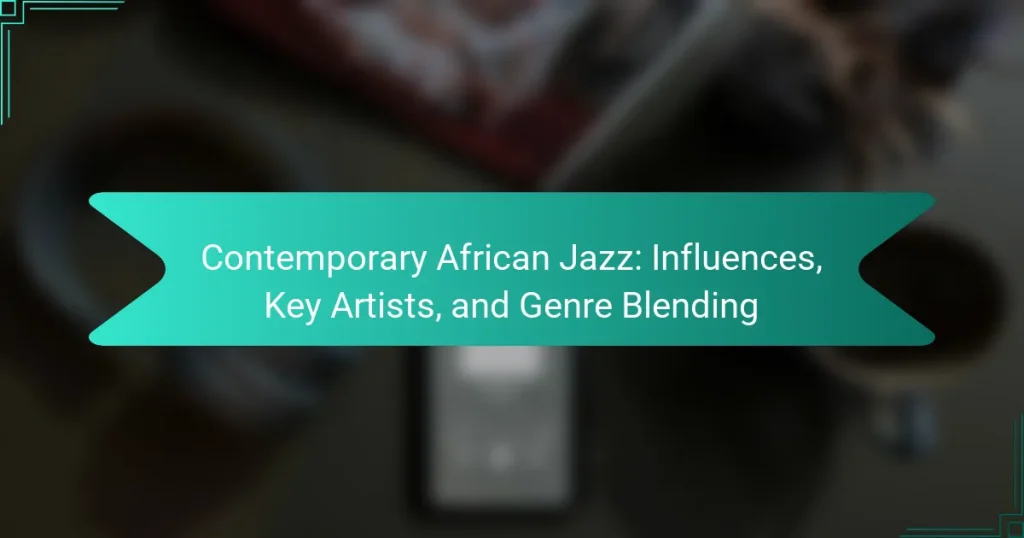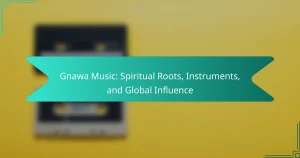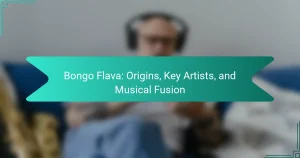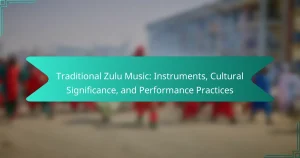Contemporary African Jazz is a modern musical genre that integrates traditional African musical elements with jazz, showcasing a vibrant blend of rhythms, instruments, and cultural influences from various African regions. Key artists such as Hugh Masekela, Abdullah Ibrahim, and Salif Keita have significantly shaped this genre, infusing their work with social and political themes while gaining global recognition. The genre is characterized by its innovative compositions that merge traditional African rhythms with jazz, funk, and hip-hop, fostering collaboration and experimentation among musicians. This dynamic evolution reflects the rich cultural diversity and expressive nature of Contemporary African Jazz.
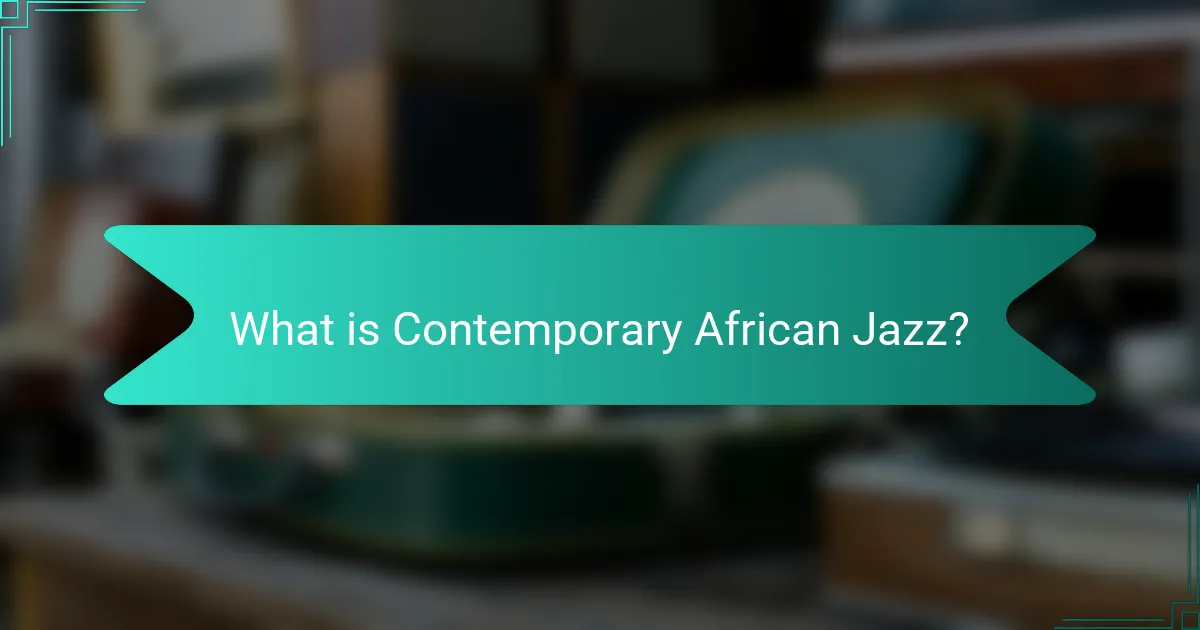
What is Contemporary African Jazz?
Contemporary African Jazz is a modern genre that blends traditional African musical elements with jazz. It incorporates diverse rhythms, instruments, and cultural influences from various African regions. Artists in this genre often fuse improvisation and complex harmonies typical of jazz with indigenous African sounds. Notable instruments include the djembe, mbira, and saxophone. This genre has evolved since the late 20th century, reflecting social and political themes. It showcases a rich tapestry of cultural expression and innovation. Influential musicians include Hugh Masekela and Mulatu Astatke. Contemporary African Jazz continues to gain global recognition and influence.
How did Contemporary African Jazz evolve over time?
Contemporary African Jazz evolved through the fusion of traditional African music and Western jazz influences. This evolution began in the mid-20th century, as musicians in Africa started incorporating jazz elements into their local music styles. The independence movements across the continent also played a significant role in shaping the genre. Artists sought to express cultural identity through music, blending rhythms and instruments unique to African heritage with jazz improvisation techniques.
Notable figures such as Hugh Masekela and Abdullah Ibrahim emerged during this period, further popularizing the genre. Masekela’s work integrated South African musical traditions with jazz, while Ibrahim focused on the spiritual and cultural aspects of African music. The rise of global communication and technology in the late 20th century facilitated cross-cultural collaborations, leading to new sounds and styles within Contemporary African Jazz.
Today, the genre continues to evolve, influenced by various global music trends and local traditions, showcasing its dynamic nature and cultural significance.
What historical events influenced the development of Contemporary African Jazz?
The development of Contemporary African Jazz was influenced by several historical events. The colonial history of Africa significantly shaped its musical landscape. The struggle for independence across various African nations in the mid-20th century fostered a sense of cultural identity. The civil rights movement in the United States also inspired African musicians. This movement highlighted themes of social justice and equality, resonating with African experiences.
The rise of pan-Africanism in the 1960s encouraged collaboration among African artists. Additionally, the globalization of music in the late 20th century introduced diverse influences into African jazz. The fusion of traditional African rhythms with jazz elements created unique sounds. These historical contexts collectively contributed to the evolution of Contemporary African Jazz.
What cultural exchanges contributed to its evolution?
Cultural exchanges between African and Western music traditions significantly contributed to the evolution of contemporary African jazz. The fusion of African rhythms with jazz elements created a unique sound. Influences from American jazz musicians, such as Duke Ellington and Louis Armstrong, introduced new styles and improvisational techniques. African music’s polyrhythms and call-and-response patterns were integrated into jazz compositions. Collaborations between African artists and international musicians further enriched the genre. The migration of African musicians to urban centers facilitated the blending of diverse musical influences. Festivals and cultural events promoted cross-cultural interactions and showcased emerging talents. These exchanges have led to the development of hybrid styles, reflecting both African heritage and global trends.
What are the defining characteristics of Contemporary African Jazz?
Contemporary African Jazz is characterized by its fusion of traditional African rhythms with modern jazz elements. This genre often incorporates diverse musical influences, including funk, hip-hop, and electronic music. Key instruments include the saxophone, trumpet, and traditional African percussion. Vocal styles frequently blend indigenous languages with jazz improvisation. The music reflects cultural narratives and social issues prevalent in African societies. Prominent artists such as Hugh Masekela and Salif Keita have significantly shaped this genre. Contemporary African Jazz also emphasizes collaboration among musicians from various backgrounds, enhancing its global appeal. The genre continues to evolve, showcasing the dynamic nature of African musical expression.
How do instrumentation and musical style differentiate it from traditional jazz?
Contemporary African jazz differentiates itself from traditional jazz through unique instrumentation and diverse musical styles. Traditional jazz typically features a standard ensemble of brass, woodwinds, piano, bass, and drums. In contrast, contemporary African jazz incorporates instruments like the mbira, kora, and various percussion instruments. This fusion creates a richer, more textured sound.
Musical style also varies significantly. Traditional jazz emphasizes improvisation within a fixed structure. Contemporary African jazz often blends improvisation with traditional African rhythms and melodies. This results in a more fluid and dynamic form of expression.
For example, artists like Hugh Masekela and Abdullah Ibrahim have integrated African musical elements into their jazz compositions. Their works showcase the distinctiveness of contemporary African jazz, highlighting how instrumentation and style set it apart from its traditional counterpart.
What role does improvisation play in Contemporary African Jazz?
Improvisation is a fundamental element in Contemporary African Jazz. It allows musicians to express creativity and individuality during performances. This genre often blends traditional African rhythms with jazz elements. Musicians frequently engage in spontaneous musical conversations, enhancing the overall experience. The influence of various cultural backgrounds contributes to diverse improvisational styles. Notable artists like Hugh Masekela and Abdullah Ibrahim exemplify this practice. Their works showcase how improvisation can reflect personal and cultural narratives. Furthermore, improvisation fosters collaboration among musicians, creating dynamic performances.
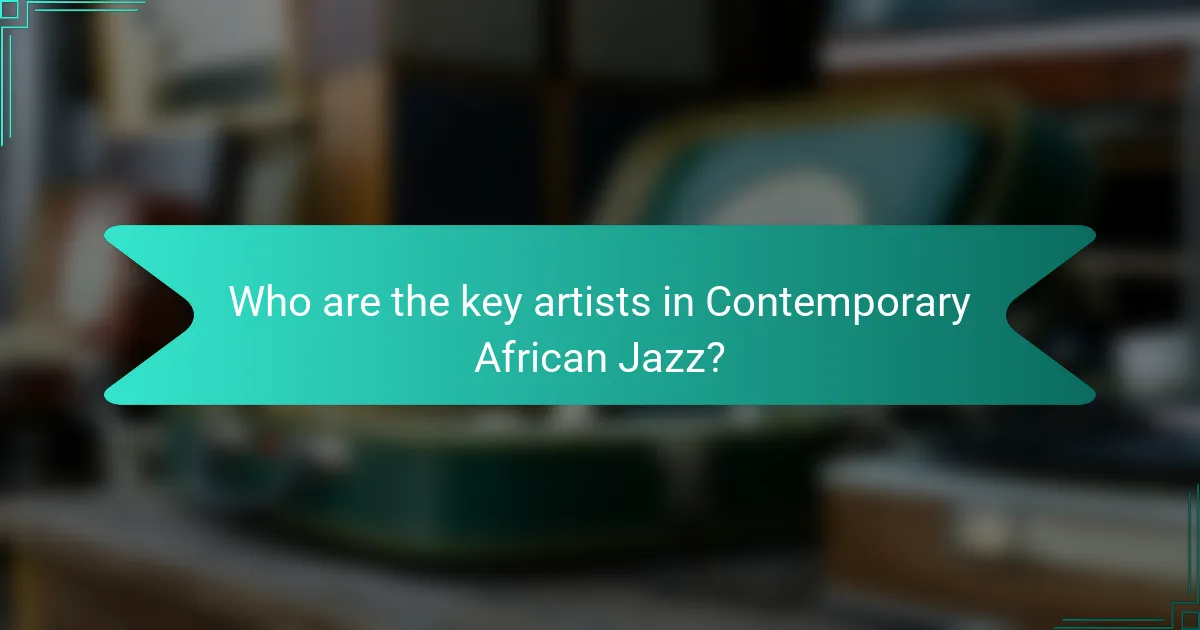
Who are the key artists in Contemporary African Jazz?
Key artists in Contemporary African Jazz include Hugh Masekela, Abdullah Ibrahim, and Salif Keita. Hugh Masekela was a prominent South African trumpeter known for blending jazz with African music. His work often addressed social issues and was influential in the anti-apartheid movement. Abdullah Ibrahim, a South African pianist, is known for his unique style that combines jazz with traditional African melodies. Salif Keita, from Mali, blends jazz with West African musical traditions, creating a distinctive sound. These artists have significantly shaped the genre, bringing global recognition to Contemporary African Jazz.
Which artists are considered pioneers in this genre?
Pioneers in contemporary African jazz include artists like Hugh Masekela and Abdullah Ibrahim. Hugh Masekela was a renowned trumpeter and composer from South Africa. He played a significant role in popularizing jazz internationally. His work often reflected the struggles against apartheid. Abdullah Ibrahim, originally known as Dollar Brand, is another influential figure. He blends traditional South African music with jazz elements. His compositions often convey deep cultural and political messages. Both artists have significantly shaped the genre’s development and global recognition. Their contributions have inspired countless musicians within and beyond Africa.
What contributions did these artists make to the genre?
These artists contributed significantly to the genre of Contemporary African Jazz through innovative fusion and cultural representation. They blended traditional African rhythms with jazz improvisation, creating unique soundscapes. Their works often incorporate indigenous instruments, enhancing the genre’s authenticity. Artists like Hugh Masekela popularized the use of trumpet in African jazz, influencing future musicians. Additionally, collaborations with international artists expanded the genre’s reach. Their contributions have led to a resurgence of interest in African musical heritage within jazz. This evolution has been documented in various music festivals and recordings, showcasing the genre’s dynamic nature.
How have their backgrounds influenced their music?
Artists’ backgrounds significantly influence their music in contemporary African jazz. Cultural heritage shapes their musical styles and themes. Many artists incorporate traditional rhythms and instruments from their regions. Personal experiences, such as migration or socio-political contexts, also inform their narratives. For instance, musicians from South Africa often reflect the country’s history in their lyrics. The fusion of various genres, like jazz, reggae, and traditional African music, showcases diverse influences. Collaborations with international artists further expand their musical horizons. This blend creates a unique sound that resonates globally.
What are some notable contemporary African jazz musicians today?
Notable contemporary African jazz musicians include Abdullah Ibrahim, Hugh Masekela, and Esperanza Spalding. Abdullah Ibrahim is a South African pianist known for blending jazz with traditional African music. His album “African Piano” showcases this unique style. Hugh Masekela, a trumpeter from South Africa, is celebrated for his contributions to jazz and activism. His song “Grazing in the Grass” gained international acclaim. Esperanza Spalding, an American bassist with African roots, incorporates African rhythms into her jazz compositions. She won a Grammy for Best New Artist in 2011, highlighting her influence in the genre. Other notable musicians include Mulatu Astatke from Ethiopia and Richard Bona from Cameroon, both of whom have made significant contributions to contemporary jazz.
What impact have these musicians had on the global music scene?
Contemporary African jazz musicians have significantly influenced the global music scene. They have introduced unique rhythms and melodies that blend traditional African sounds with jazz elements. Artists like Hugh Masekela and Abdullah Ibrahim have showcased African culture through their music. Their works have reached international audiences, promoting cultural exchange. Collaborations with Western artists have further integrated African jazz into global music. Festivals and events dedicated to African jazz have emerged worldwide, highlighting its growing popularity. This genre has inspired new musical movements and styles across various cultures. The impact of these musicians continues to shape the evolution of jazz globally.
How do these artists blend traditional and modern influences in their work?
These artists blend traditional and modern influences by incorporating indigenous rhythms and instruments into contemporary jazz compositions. They often use traditional African musical scales and motifs, which create a unique sound. For example, artists like Hugh Masekela and Salif Keita integrate local folk styles with jazz improvisation. This fusion allows them to maintain cultural authenticity while appealing to global audiences. Additionally, modern technology plays a role in their work. They utilize digital production techniques to enhance traditional sounds. This combination of old and new creates a rich, dynamic musical experience.
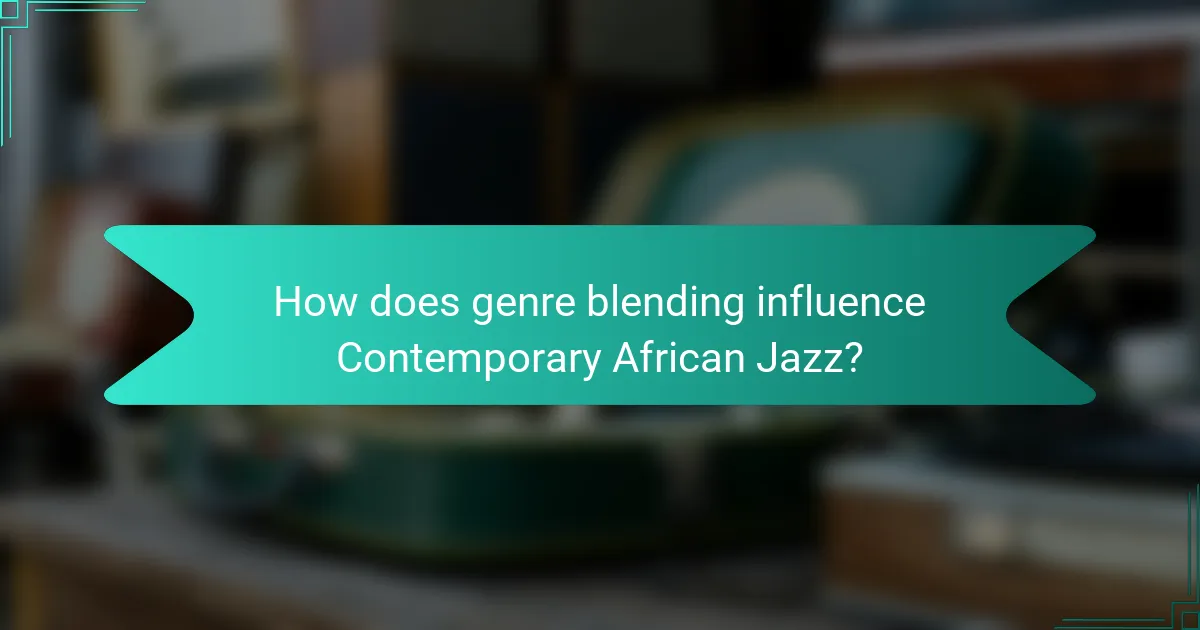
How does genre blending influence Contemporary African Jazz?
Genre blending significantly influences Contemporary African Jazz by incorporating diverse musical styles. This fusion creates a unique sound that reflects cultural diversity. Artists often merge traditional African rhythms with jazz, funk, and hip-hop elements. For example, the use of polyrhythms from African music enhances jazz improvisation. This blend allows for innovative compositions that resonate with broader audiences. Additionally, genre blending fosters collaboration among musicians from different backgrounds. It encourages experimentation, pushing the boundaries of traditional jazz forms. The result is a dynamic genre that evolves continuously, appealing to both local and global listeners.
What other genres are commonly fused with Contemporary African Jazz?
Contemporary African Jazz is commonly fused with genres such as Afrobeat, funk, and traditional African music. Afrobeat, characterized by its rhythmic grooves, enhances the jazz elements with vibrant percussion. Funk contributes a strong bassline and syncopated rhythms, creating a danceable fusion. Traditional African music brings indigenous instruments and melodies, enriching the jazz soundscape. These genre fusions reflect the diverse musical heritage of Africa and its contemporary evolution. The blending of these styles has led to innovative sounds and new artistic expressions in the jazz genre.
How does this blending create new musical experiences?
Blending different musical styles creates new musical experiences by combining diverse rhythms, melodies, and cultural influences. This fusion allows artists to experiment with traditional African sounds alongside genres like jazz, funk, and hip-hop. The result is a rich tapestry of music that can evoke various emotions and connect with a broader audience. For example, the incorporation of African percussion instruments into jazz creates unique rhythmic patterns that enhance the listening experience. Additionally, blending genres often leads to innovative improvisation techniques, showcasing the artists’ creativity. This cross-pollination of styles has led to the emergence of new subgenres, further expanding the musical landscape. Notable artists like Hugh Masekela and Fela Kuti exemplify how blending can create a powerful, transformative musical experience. Their works highlight the ability of genre blending to break cultural barriers and foster global connections through music.
What are some examples of successful genre-blending albums or tracks?
Successful genre-blending albums include “Blackstar” by David Bowie and “To Pimp a Butterfly” by Kendrick Lamar. “Blackstar” fuses jazz, rock, and electronic elements. It showcases Bowie’s innovative approach to music. “To Pimp a Butterfly” blends hip-hop, jazz, and funk. It received critical acclaim for its lyrical depth and musical complexity. Another notable example is “In the Aeroplane Over the Sea” by Neutral Milk Hotel, which combines indie rock with folk and orchestral influences. These albums highlight the creative possibilities of merging different genres.
Why is genre blending important for the evolution of Contemporary African Jazz?
Genre blending is crucial for the evolution of Contemporary African Jazz as it fosters innovation and diversity. This blending incorporates various musical styles, including traditional African rhythms, jazz, funk, and hip-hop. It allows artists to create unique sounds that reflect their cultural identities. For instance, musicians like Hugh Masekela and Abdullah Ibrahim have successfully integrated different genres into their work. This fusion attracts a broader audience and cultivates a richer musical landscape. Moreover, genre blending encourages collaboration among artists from different backgrounds. This collaboration often leads to the emergence of new sub-genres and styles. Ultimately, genre blending enhances the global appeal of Contemporary African Jazz while preserving its roots.
How does it reflect cultural diversity and innovation?
Contemporary African jazz reflects cultural diversity and innovation through its fusion of various musical traditions. This genre blends indigenous African rhythms with elements from jazz, blues, funk, and other global music styles. Key artists like Hugh Masekela and Abdullah Ibrahim incorporate diverse cultural influences into their compositions. Their music often features traditional instruments alongside modern ones, showcasing a blend of heritage and contemporary sounds. This innovative approach attracts a global audience, promoting cross-cultural exchange. The genre’s evolution highlights the dynamic nature of African cultural expressions, as artists continually experiment and redefine musical boundaries.
What challenges do artists face when blending genres?
Artists face several challenges when blending genres. One major challenge is maintaining a cohesive sound. Different genres have distinct characteristics that may clash when combined. This can lead to confusion for listeners. Another challenge is audience reception. Fans of a specific genre may resist changes. Artists must also navigate industry expectations. Record labels often prefer clear genre definitions for marketing. Additionally, technical skills can be a barrier. Mastery of multiple genres requires extensive training and practice. Lastly, cultural appropriation issues can arise. Artists must be sensitive to the origins of the genres they blend.
What can listeners do to appreciate Contemporary African Jazz more fully?
Listeners can appreciate Contemporary African Jazz more fully by actively exploring its diverse influences. This genre blends traditional African music with jazz elements. Engaging with various artists enhances understanding of the genre’s depth. Listening to key artists like Abdullah Ibrahim and Hugh Masekela showcases unique styles. Attending live performances offers a firsthand experience of the music’s vibrancy. Reading about the cultural context provides insight into its origins and evolution. Participating in discussions or forums can deepen appreciation through shared perspectives. Exploring related genres like Afrobeat or Highlife reveals interconnected musical threads.
How can one explore various artists and their unique styles?
One can explore various artists and their unique styles by attending live performances. Live music events showcase artists’ distinct sounds and techniques. Listening to recordings is another effective method. Many platforms provide access to a wide range of artists’ works. Engaging with online music communities can facilitate discussions about different styles. Social media platforms often feature artists sharing their creative processes. Visiting art galleries and exhibitions can also provide insights into artists’ inspirations. Reading artist interviews and biographies offers deeper understanding of their backgrounds. Lastly, participating in workshops can allow for hands-on experience with different musical styles.
What resources are available for learning about the genre’s history and influences?
Books on Contemporary African Jazz provide comprehensive insights. “African Rhythm and African Sensibility” by John Miller Chernoff explores cultural influences. “The African Imagination in Music” by Kofi Agawu discusses musical traditions. Online platforms like JSTOR offer academic articles on genre history. Documentaries such as “The Last Song Before the War” highlight influential artists and their impact. Music archives and libraries house recordings and interviews with key figures. These resources collectively offer valuable knowledge on the genre’s evolution and influences.
Contemporary African Jazz is a modern musical genre that combines traditional African elements with jazz, characterized by unique instrumentation and diverse styles. The article explores its evolution since the mid-20th century, influenced by historical events and cultural exchanges, showcasing key artists like Hugh Masekela and Abdullah Ibrahim. It highlights the genre’s defining characteristics, the role of improvisation, and the impact of genre blending on its development. Additionally, the article examines the challenges artists face and offers resources for listeners to deepen their appreciation of this dynamic genre.
